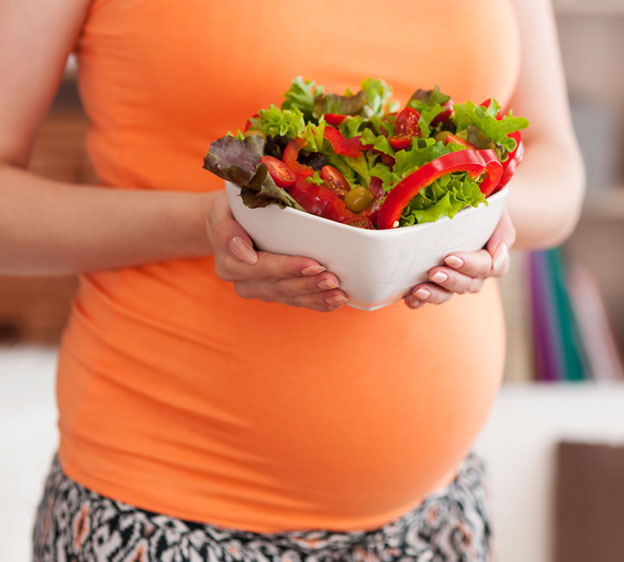Fueling a Healthy Pregnancy: Your Guide to a Gestational Diabetes Diet
March 14, 2023
You took the dreaded glucose challenge test — and your results showed that you have gestational diabetes. You may be wondering how to stay healthy through the rest of your pregnancy.
While you may have all sorts of questions after being diagnosed with gestational diabetes, take a deep breath. There’s good news: You can take steps to lower your blood sugar to a healthy range, protecting you and your baby.
Defining Gestational Diabetes
First things first, what is gestational diabetes? Gestational diabetes is a type of diabetes that occurs during pregnancy. When you’re diagnosed with the condition, it means that you have higher-than-normal blood sugar levels.
"The diagnosis can put mom and baby at risk, increasing the risk of premature birth and excess birth weight, which can make delivery more difficult," explains Dr. Curtis J. Elam, board-certified physician with Beaufort Memorial Obstetrics & Gynecology Specialists. "Having gestational diabetes also increases the mother’s risk of having Type 2 diabetes after pregnancy."
Gestational diabetes generally does not cause symptoms, so you may not realize you have it without getting screened, which typically happens between weeks 24 and 28 of pregnancy. Gestational diabetes tests involve you drinking a sugary liquid and then having your blood drawn. If your blood sugar levels are high, you have gestational diabetes.
Read More: What Is Gestational Diabetes?
Finding the Right Gestational Diabetes Diet for You
There’s no specific diet plan for gestational diabetes, but practicing healthy eating habits can make a big impact. In many cases, changing your diet can lower your blood sugar and get it within a healthy range.
"A gestational diabetes diet focuses on whole foods that lower blood sugar during pregnancy," Dr. Elam says. "It does not require you to eliminate certain foods or food groups. It simply involves following a few basic guidelines to ensure you and your growing baby get the nutrition you need."
- Fill your plate with fruits and veggies. These healthy foods should be the basis of your diet. They’re loaded with healthy nutrients and antioxidants and free of added sugar and unhealthy fats. Whole fruits are best, so choose an orange rather than a glass of orange juice, which may have extra sugar.
- Choose your carbs wisely. Being diagnosed with diabetes does not mean carbs are the enemy. They are a key part of any healthy diet, and there’s no specific number of them you can have each day. Get your carb fix (and energy boost) through non-starchy vegetables, such as green beans and bell peppers, whole grains, and beans.
- Go lean. Choose lean sources of protein, such as eggs, chicken, turkey and low-fat dairy. You can also get protein from fish. Bonus: Experts recommend that pregnant women eat up to 12 ounces of low-mercury fatty fish — think salmon, sardines and trout — each week to get omega-3 fatty acids that promote baby’s brain growth and development.
- Choose healthy fats. Not all fat is bad! Those omega-3 fatty acids mentioned above are one example of a healthy fat. You can also find healthy, unsaturated fats in avocados, olives and olive oil, vegetable oils, nuts, and seeds.
- Eat small meals throughout the day. It can be easier to keep your blood sugar levels in a normal range — and to keep from “hangry” binge eating — if you fuel your body with snacks and small meals at regular intervals. Planning out your food for the day ahead of time can also be helpful.
- Drink plenty of water. Staying hydrated is especially important during pregnancy. Stick with water and avoid sugary beverages. Diet soda isn’t specifically off limits, but it often contains caffeine, so talk with your OBGYN about how much is OK.
“While you can manage gestational diabetes with changes to your diet, it’s important to note that gestational diabetes is typically not the result of what you eat,” says Dr. Elam. “Gestational diabetes is caused by the body’s inability to produce enough insulin during pregnancy to keep your blood sugar in a normal range. Pregnancy-related hormones can interfere with insulin production, and then the body struggles to keep up.”
Read More: What to Eat During Pregnancy
Exercise for a Healthy Pregnancy
Staying physically active, like a healthy gestational diabetes diet, helps you keep blood sugar in a healthy range.
Talk with your OBGYN about how much exercise is right for you and what types of exercise will work best. The American College of Obstetricians and Gynecologists recommends at least 150 minutes of moderate-intensity aerobic activity a week. Low-impact exercises, such as walking, swimming, spinning and water aerobics, are easier on your joints, which are under added strain during pregnancy. Plus, because pregnancy can affect your balance, these exercises pose a lower risk of injury than other workouts.
If diet and exercise together aren’t enough to keep your blood sugar levels in a healthy range, your OBGYN may prescribe insulin injections or oral medications to help supplement the insulin your body is producing. A glucometer can also help you and your provider determine whether glucose levels are within proper range, Edwards adds.
Even if you do require medications to manage gestational diabetes, continue eating well and exercising as much as you’re able. A healthy lifestyle will help you and your baby stay healthy during those precious nine months.
Expecting a new addition to the family? Request an appointment with an OBGYN, who can guide you through a safe and healthy pregnancy.
Updated: April 2025

